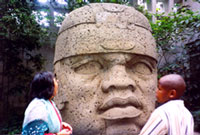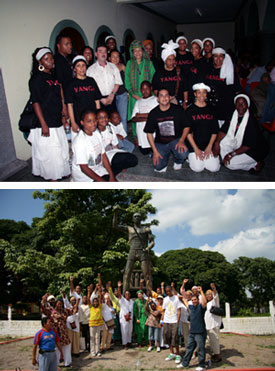Revisiting MXODUS Tours August, 2007 in an old touring car going downhill 48 miles per hour
More colmuns by Mother Tynnetta Muhammad
 “And certainly We have made the Word to have many connections for their sake, so that they may be mindful. Those to whom We gave the Book before it, they are believers in it. And when it is recited to them they say: We believe in it; surely it is the Truth from our Lord; we were indeed before this submitting ones. These will be granted their reward twice, because they are steadfast, and they repel evil with good and spend out of what We have given them.” –Holy Qur’an, Surah 28, verses 51-54
“And certainly We have made the Word to have many connections for their sake, so that they may be mindful. Those to whom We gave the Book before it, they are believers in it. And when it is recited to them they say: We believe in it; surely it is the Truth from our Lord; we were indeed before this submitting ones. These will be granted their reward twice, because they are steadfast, and they repel evil with good and spend out of what We have given them.” –Holy Qur’an, Surah 28, verses 51-54

In resuming our studies of MXODUS Tours taking us to the South of Mexico, principally to the states of Veracruz, Tobasco and Chiapas, our touring bus and travelers, young and older adults, were focused on learning our history, both from the ancient past and contemporary times. We had a comprehensive view of the roots of the Black man and family from the perspective of ancient migratory origins on our planet and inclusive of the African Diaspora in Mexico, Central America as well as in the rest of the American continent. Everyday, we faced a new challenge and reality beginning at the museum in Xlapa, the capitol of Veracruz, to our stopover in the port city of Veracruz in the Gulf of Mexico to the Olmec healing center of Catemaco, to the mysterious archeological site of Tajin, to the ancient site of Papantla to view the mysterious spinning Voledores ceremony as they descended on ropes from a 30-meter height at the top.
In this article, we will conclude with a review of our journey through the state of Veracruz to the pivotal event of the marking of the Yanga Festival held in the municipality of Yanga, near the city of Cordaba, with our great host, Professor Toni-Mokjaetji Humber, Ph.D. On this particular occasion, Dr. Humber was inspired to write a special song and chorus celebrating the hero figure of Yanga, the first Black liberator of the Americas. Quoting from her study book manual on the African Diaspora in Mexico Tour, 2007, she writes:

“Gaspar Nyanga, the first liberator of the Americas, is pivotal to this investigation. Few people in Mexico and even fewer in the United States have ever heard of him or the town named for him or the annual festival held in his honor. This year our participation will establish an important link with the Yangan community, and as a result of our visit(s) to Yanga, his name and fame will be introduced to our families, friends and associates. We will be a dynamic force to retell his story, celebrate his courageous deeds and inform others of this important revolutionary figure in the liberation of enslaved Africans and indigenous peoples of the Americas.
“I applaud you for embarking upon this adventure to trace the African heritage in Mexico. This tour will provide a whirl-wind of experiences as we travel from Mexico City to two states along the Gulf of Mexico–Veracruz and Tabasco–and to forested regions in Chiapas where we will be deep in the Mayan Archaeological Zone. Our first stop will be Xalapa, Veracruz, to get our first view of the colossal Olmec heads and artifacts in the Museo Antropologia de Xalapa. We then will travel to Puerto Veracruz, an important port of entry for enslaved Africans into Mexico. We will visit Laguna Mandinga, a community founded by African Mexicans.
“The tour will continue to Cordoba and Yanga, where we will participate in the Fiesta de la Negrtud by presenting a tribute to Gaspar Nyanga, first liberator of the Americas. While we trace the African heritage in the town of Yanga, we will visit Mata Clara, an African Mexican community. We then travel to the heart of the Olmecs in Tres Zapotes and Catemaco in Veracruz and to La Venta–site of the first pyramid in the Americas–and to Villahermosa in Tabasco. Finally, we travel to three sites in the Mayan Archaeological Zone to learn about the profound connections between ancient Kemetic people (Egyptians), the Olmecs, and the Mayans. We will tour the great pyramid complex at Palenque, the remarkable Temples of Paintings at Bonampak and the dramatic Mayan site of Yaxchilan. To reach Yaxchilan, we will cross the Usumacinta River by boat in the Lancandon Rainforest, home of the Lancandon Indians, last of the Mayan ancestors who continue to honor their traditional ways of living. Finally, we will visit some of the most beautiful waterfalls in Mexico at Parque Nacional Agua Azul. This indeed will be an incredible journey for all to remember!!!!”
At the Yanga Festival this year, we had a delightful experience of performing with our group before audiences of Black and Mexican families, our representation of the importance of Yanga to Black history as now being introduced to our American families. The lead orator and Spanish interpreter was a gifted, young student growing up in Mexico, being schooled in the Spanish language and history, 16-year-old Brother Khalifah, member of our own family, who had the starring role. Congratulations to all those who performed in our presentation at the Yanga Festival.
“And when they hear idle talk, they turn aside from it and say: For us are our deeds and for you your deeds. Peace be to you! We desire not the ignorant. Surely thou canst not guide whom thou lovest, but Allah guides whom He pleases; and He knows best those who walk aright. And they say: If we follow the guidance with thee, we should be carried off from our country. Have We not settled them in a safe, sacred territory to which fruits of every kind are drawn? A sustenance from Us–but most of them know not. And how many a town have We destroyed which exulted in its means of subsistence! So those are their abodes: they have not been dwelt in after them except a little. And we are ever the inheritors. And thy Lord never destroyed the towns, until He had raised in their metropolis a messenger, reciting to them Our messages, and We never destroyed the towns except when their people were iniquitous.”—Holy Qur’an, Surah 28, verses 55-59
To be continued.












